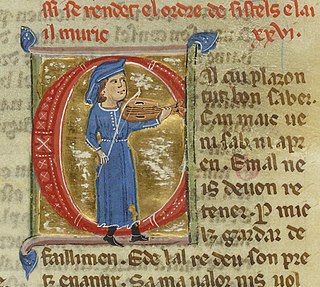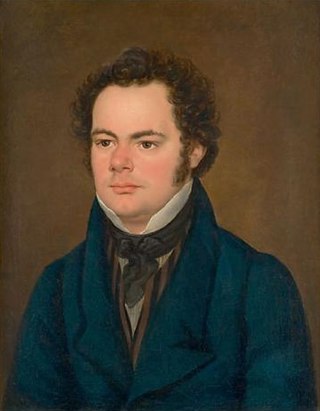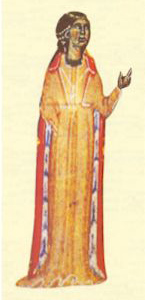Fourth stanza, explaining how Jesus was born of Mary to save sinners:
- Since he was of woman born,
- God saved women;
- And he was born a man
- To save men.
O Maria, Deu maire ("O Mary, mother of God") is an Old Occitan song, a hymn to the Virgin Mary, unique in being both the only song from the Saint Martial school (the chantry of the Abbey of Saint Martial at Limoges) that is entirely in the vernacular (having no Latin stanza or refrain) and the only medieval Occitan song with extant musical notation for all its (twelve) stanzas. [1] It dates to the 1090s and is preserved in MS f. lat. 1139 of the Bibliothèque nationale de France. [2] It has been translated into English. [3]
A liturgical song, O Maria was designed to communicate sacred truth to the people in a language they could understand, although usually this was done through a mixture of Latin and vernacular verses. The melody of the piece basically repeats for each stanza with only minor variations. The later songs of the troubadours, composed in the same style, were never transcribed with more than one stanza of music. It has been suggested that, like O Maria, subsequent stanzas were melodically similar with only minor variations. Similarities have been drawn between the music of O Maria and that of a ninth-century hymn to the Virgin, Ave maris stella ("Hail, star of the sea"), [4] and also between O Maria and Reis glorios, verais lums e clardatz ("Glorious King, true light and brilliance"), an alba by the troubadour Guiraut de Bornelh (fl.c.1200). The latter may be a contrafactum or just a metrical imitation, although its words cannot be presumed to have any similar religious significance. [5]

A troubadour was a composer and performer of Old Occitan lyric poetry during the High Middle Ages (1100–1350). Since the word troubadour is etymologically masculine, a female equivalent is usually called a trobairitz.
Poetry took numerous forms in medieval Europe, for example, lyric and epic poetry. The troubadours, trouvères, and the minnesänger are known for composing their lyric poetry about courtly love usually accompanied by an instrument.
Occitan literature is a body of texts written in Occitan, mostly in the south of France. It was the first literature written in a Romance language and inspired the rise of vernacular literature throughout medieval Europe. Occitan literature's Golden Age was in the 12th century, when a rich and complex body of lyrical poetry was produced by troubadours writing in Old Occitan, which still survives to this day. Although Catalan is considered by some a variety of Occitan, this article will not deal with Catalan literature, which started diverging from its Southern French counterpart in the late 13th century.

"Ellens dritter Gesang", in English: "Ellen's Third Song", was composed by Franz Schubert in 1825 as part of his Op. 52, a setting of seven songs from Walter Scott's 1810 popular narrative poem The Lady of the Lake, loosely translated into German.

Peire Cardenal was a troubadour known for his satirical sirventes and his dislike of the clergy. Ninety-six pieces of his remain, a number rarely matched by other poets of the age.

Azalais de Porcairagues or Alasais de Porcaragues was a trobairitz, composing in Occitan in the late 12th century.

The trobairitz were Occitan female troubadours of the 12th and 13th centuries, active from around 1170 to approximately 1260. Trobairitz is both singular and plural.

"O Sacred Head, Now Wounded" is a Christian Passion hymn based on a Latin text written during the Middle Ages. Paul Gerhardt wrote a German version which is known by its incipit, "O Haupt voll Blut und Wunden".

"O come, O come, Emmanuel" is a Christian hymn for Advent, which is also often published in books of Christmas carols. The text was originally written in Latin. It is a metrical paraphrase of the O Antiphons, a series of plainchant antiphons attached to the Magnificat at Vespers over the final days before Christmas. The hymn has its origins over 1,200 years ago in monastic life in the 8th or 9th century. Seven days before Christmas Eve monasteries would sing the “O antiphons” in anticipation of Christmas Eve when the eighth antiphon, “O Virgo virginum” would be sung before and after Mary's canticle, the Magnificat. The Latin metrical form of the hymn was composed as early as the 12th century.

Raimon Vidal de Bezaudu(n) (Catalan: Ramon Vidal de Besalú) (flourished early 13th century) was a Catalan troubadour from Besalú. He is notable for authoring the first tract in a Romance language (Occitan) on the subject of grammar and poetry, the Razós de trobar (c. 1210), a title which translates as "Reasons (or Guidelines) of troubadour composition". He began his career as a joglar and he spent his formative years at the court of Hug de Mataplana, which he often recalls fondly in his poems and songs.

Giraut or Guiraut de Calanso or Calanson was a Gascon troubadour in the Occitan language. Of his lyric works that remain five are cansos, two descorts, a congé, a planh, and a vers. He also wrote a mock ensenhamen entitled Fadet juglar.
Bieiris de Roman(s) was a trobairitz of the first half of the thirteenth century. Her birthplace was Romans near Montélimar. Other than her name, which includes her place of birth, nothing is known of the details of her life, which has led to a significant gap in knowledge for scholarship analyzing her work. She left behind one canso, "Na Maria, pretz e fina valors", addressed to another woman named Mary. The poem is written in the typical troubadour style of courtly love and has been consequently analyzed as a lesbian poem. Bieiris may, however, be simply writing from the masculine point of view, fully immersing herself in the masculinity of the genre. Nonetheless, the certain ascription of the poem to a woman makes it unlikely that there was any attempt to "fool" the audience: the poem is consequently emasculated. The Na Maria of the poem has even been interpreted as the Virgin Mary, and the sincerity and innocence of the lyrics do not disqualify it.

O filii et filiae is a Christian hymn celebrating Easter. It is attributed to Jean Tisserand, a Franciscan friar.
A Crusade song is any vernacular lyric poem about the Crusades. Crusade songs were popular in the High Middle Ages: 106 survive in Occitan, forty in Old French, thirty in Middle High German, two in Italian, and one in Old Castilian. The study of the Crusade song, which may be considered a genre of its own, was pioneered by Kurt Lewent. He provided a classification of Crusade songs and distinguished between songs which merely mentioned, in some form, a Crusade from songs which were "Crusade songs". Since Lewent, scholars have added several classifications and definitions of Crusade songs. Scholars have argued for three different classifications of Crusade songs which include songs of exhortation, love songs, and songs which criticize the Crusading movement.
Tribolet was an obscure troubadour, known only for one song, the obscene Us fotaires que no fo amoros. The song's rubric was read as t'bolet by Giulio Bertoni, who identified its composer as Tremoleta, but Alfred Jeanroy suggested the reading "Tribolet", which is widely accepted. He also suggested that the composition attributed to him is a parody of a piece now lost. The song is preserved in one chansonnier (G, folio 128) dating from the final third of the thirteenth century, the same period in which the song may have been written.
A salut d'amor or (e)pistola ("epistle") was an Occitan lyric poem of the troubadours, written as a letter from one lover to another in the tradition of courtly love. Some songs preserved in the Italian Quattrocento and Cinquecento chansonniers are labelled in the rubrics as saluts, but the salut is not treated as a genre by medieval Occitan grammarians. The trouvères copied the Occitan song style into Old French as the salut d'amour. There are a total of nineteen surviving Occitan saluts and twelve French ones, with a Catalan examples also.

Matfre Ermengau was a Franciscan friar, legist, and troubadour from Béziers. He had a master of laws degree.
Bonfilh or Bonfils was a Jewish troubadour from Narbonne. He is the only known Jew who wrote in the troubadour style and language, Old Occitan. His only known work is a partimen (debate) with Guiraut Riquier, Auzit ay dir, Bofil, que saps trobar. It has been suggested that Bonhilh may have been a poetic invention of Guiraut and not a historical person, or that he was the same person as the Jewish poet Abraham Bedersi. There is a lacuna in the only surviving manuscript version of this song that lasts from the middle of the third stanza through to the middle of the fifth. The seventh stanza is also missing the ending of its final line. Each stanza has eight lines, but the last two are tornadas of four each.
Isaac Gorni was a late thirteenth-century Hebrew lyric poet from Aire-sur-l'Adour in Gascony, then ruled by the English Prince Edward. Isaac probably left Gascony before the Jews were expelled by a royal edict of 1287, perhaps in 1275, 1281, or 1282, when heavy taxes were collected from the Jews. His surname derives from the Hebrew goren, "threshing floor", the Occitan for which is aire, as in his birthplace.
The serena is a minor Old Occitan lyric genre. Despite the name, it is not a serenade. Rather, it is a counterpart to the alba. In an alba, the lover laments the coming of the dawn that forces lovers to part. In the serena, the lover complains of the long wait for evening to arrive so he can consummate his love. The genre was invented late in the history of the Occitan lyric by the troubadour Guiraut Riquier in his song Ad un fin aman fon datz, which he claimed to have completed in the year 1263, when he was living in Narbonne. The refrain of Guiraut's serena goes:










